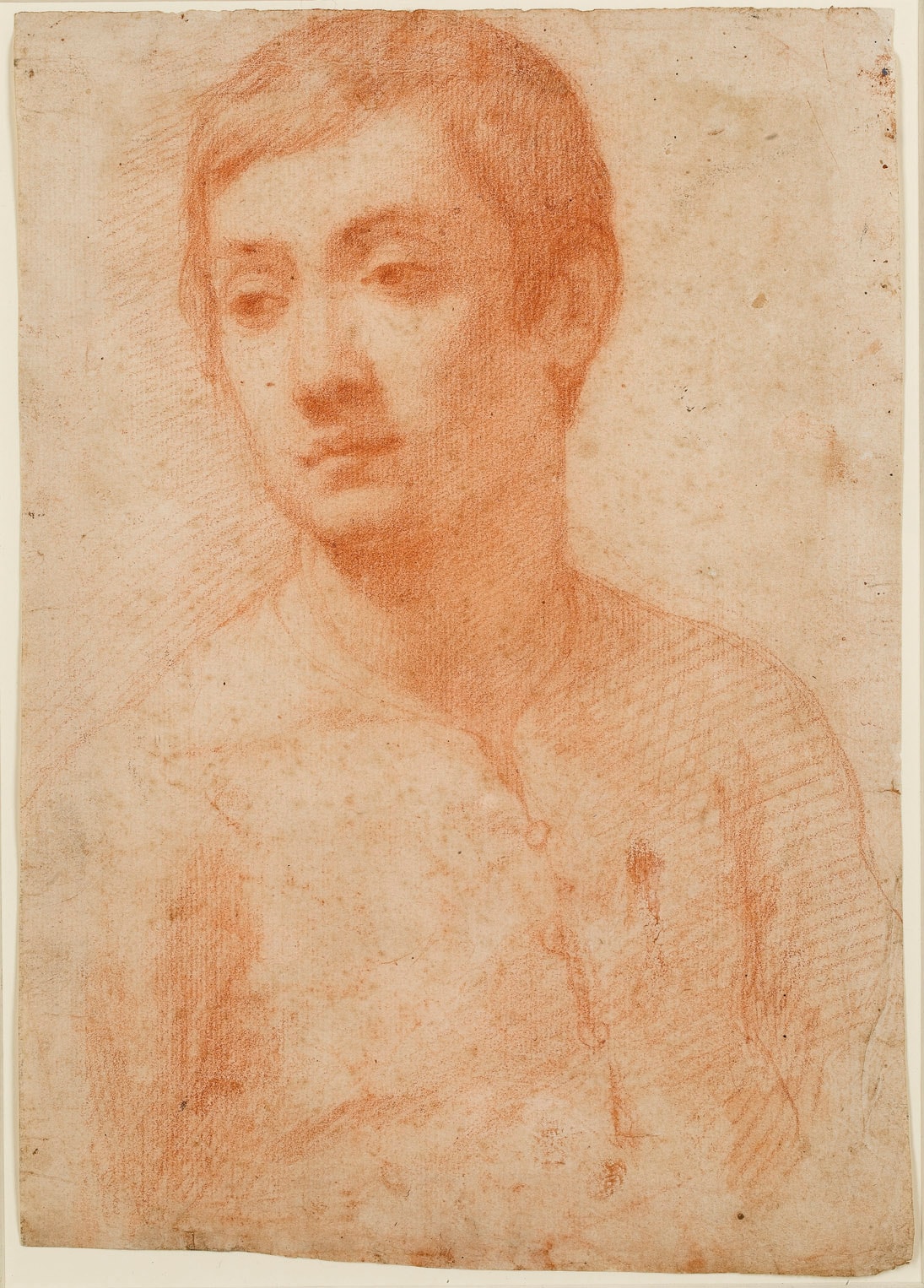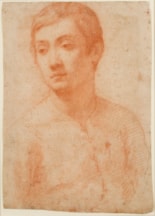Domenico Cresti PASSIGNANO
(Passignano 1559 - Florence 1638)
The Head of a Youth
Sold
Red chalk.
Irregularly trimmed.
Inscribed Del Pasigniano on the old backing sheet.
282 x 200 mm. (11 1/8 x 7 7/8 in.) at greatest dimensions.
ACQUIRED BY THE MUSEUM OF FINE ARTS, HOUSTON, TEXAS.
Irregularly trimmed.
Inscribed Del Pasigniano on the old backing sheet.
282 x 200 mm. (11 1/8 x 7 7/8 in.) at greatest dimensions.
ACQUIRED BY THE MUSEUM OF FINE ARTS, HOUSTON, TEXAS.
The present sheet bore an old and probably contemporary attribution to Passignano, and is a fine example of the ‘morbidezza’ or softness noted by Baldinucci as a particular characteristic of the artist’s drawings. The delicate handling of red chalk and the treatment of hair is found throughout the artist’s oeuvre as a draughtsman, and is seen for example in a study of a seated male nude, formerly in a French private collection and sold at auction in 1987. The facial type of this pensive young man is likewise found in numerous paintings and drawings by the artist. It has been suggested that the soft, sensual expression characteristic of such youths in Passignano’s work may reflect something of the influence of Caravaggio’s paintings, which he would have seen in Rome in the first decade of the 17th century.
Domenico Cresti, known as Passignano after his birthplace, was trained in the Florentine studios of the painters Girolamo Macchietti and Giambattista Naldini. The influence of Federico Zuccaro, whom he assisted on the decoration of the cupola of the Duomo in Florence in the second half of the 1570’s, was of particular significance for the young artist. Passignano accompanied Zuccaro to Rome in 1579 and soon afterwards to Venice, where he spent several years and where his careful study of such local painters as Tintoretto was to be reflected in his own paintings throughout his later career. On his return to Florence at the end of the 1580’s, Passignano contributed to the ephemeral decorations created for the wedding of Ferdinando de’ Medici and Christina of Lorraine and painted frescoes for the Cappella Salviati in the church of San Marco. He was admitted into the Accademia del Disegno in 1589, and was soon earning important ecclesiastical commissions in Florence, including a Preaching of Saint John the Baptist for San Michele Visdomini, as well as painting frescoes for the Medici villa at Artimino and altarpieces for churches in Lucca, Pistoia and Pisa. In the late 1590’s he painted two large murals on slate, depicting scenes from the life of Cosimo I de’ Medici, for the Salone dei Cinquecento in the Palazzo Vecchio, where they were paired with paintings by Jacopo Ligozzi.
Established as one of the leading painters in Florence, Passignano was summoned to Rome in 1602 to paint a large altarpiece for St. Peter’s. He remained in the city for thirteen years, receiving commissions from such important patrons as Pope Paul V, Scipione Borghese, Maffeo Barberini and Pietro Aldobrandini, and working at Sant’Andrea della Valle and Santa Maria Maggiore. Returning to Florence in 1616, his successful career continued with numerous projects for churches and palaces, including work for the Medici at the Palazzo Pitti and elsewhere. Although Passignano again worked for some time in Rome in the mid-1620’s, he spent his last decade living in Florence, painting relatively few works but remaining closely associated with the Accademia del Disegno.
Although the 17th century Florentine biographer Filippo Baldinucci praised Passignano as a draughtsman, writing that ‘I disegni del Passignano sono maravigliosi per la nobilità della maniera, e per una loro propria morbidezza e pastosità’, his drawings have remained comparatively less studied than those of other Florentine artists of the period such as Ludovico Cigoli. Like most of his contemporaries, Passignano prepared his paintings with compositional sketches in pen and ink and followed this with single figure studies in chalk, drawn from a posed model. He was devoted to life drawing, and a number of academic studies of male nudes in red chalk by the artist survive today in the Uffizi, the Louvre and elsewhere.




